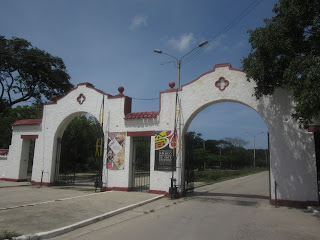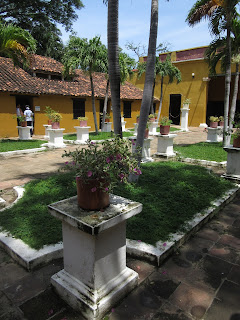After a day filled with lots of exercise yesterday, it was
great to have a slow day planned. We took a local bus to the outskirts of
Quinta de San Pedro Alejandrino, the large estate belonging to a wealthy landowner, where Simon Jose Antonio de la Santisma Trinidad Bolivar y Palacios, better known as Simon Bolivar, spent his remaining days before he died at the age of 47. I think that must be one of the, if not the, longest names I've heard! Bolivar, as I wrote previously, was instrumental in bringing independence to several countries in Latin America.
Upon entering the property, the first thing we saw was the large Botanical Garden that had been established in 2004 in cooperation with the local university and the association of national botanical gardens.
The estate was founded in 1608 as a sugar cane factory and was the property of a high-ranking official at the cathedral. That job must have paid well, don't you think! The estate eventually was owned by Don Joaquinde Mier y Benitez who provided housing to Bolivar until his death on December 17th, 1831. Benitez' son sold the estate to the Magdalena Department, i.e. the local state or province, in 1891.
The Altar de la Patria or Altar of the Homeland, was constructed in 1980 to commemorate the 150th anniversary of the death of Simon Bolivar.
All the continent's flags lined the walkway as an expression of unity and to pay tribute to the memory of the man known as the Libertador or Liberator.
In front of the huge monument to Simon Bolivar was an attractive lotus pond. I read there that the word 'lotus' comes from the Greek nymph who expressed his preference for water as did those fantastic beings!
The lotus flower is an aquatic perennial herb from Africa and Asia in which the main part of the plant is submerged, showing only large, floating leaves and flowers. Some species flower overnight.
This cone-shaped top Trapiche was where the estate's sugar cane was processed. The extracted juice would reach the bottom of the furnace where the honey-like substance would be cooked.
We walked through the adjoining rooms of the estate that 'served as testimony to life at the hacienda during the 19th century.' In the main living room were paintings of the Liberator and Joaquin de Mier, the owner of the estate.
In the middle of the quinta or country villa was a lovely courtyard that was so peaceful to walk through before seeing more items belonging to Bolivar.
The painting represented Bolivar on his deathbed during the last moments in his life where he was, according to the artist, joined by a group of nine men in his entourage.
Just in case the painting wasn't enough, next was a life-sized recumbent statue of Bolivar that represented the veiling of his body. The statue was done in marble and based on the death mask of the Liberator while his body was lying in state.
This bedroom or 'sacred location' where Bolivar passed away contained some of his personal belongings. Also reserved were the military camp bed where he died and the armchair where Bolivar dictated his Last Will and Testament and the Last Proclamation on December 10th, 1830.
The original clock displayed the exact moment of his death at 1:3:55 on December 17th, 1830.
An oven, cast iron cooking pots and other items from the time period were displayed in the kitchen.
Bolivar's French doctor, Alejandro Prospero Reverend, ordered a diet based on sago flower prepared with wine and chicken broth. The Sago Palm is sometimes known as a living fossil as it has been in existence for more than 300 million years! It is an ornamental species easily confused with other palms. The sago flour prepared from its trunk is also used as a nutritional beverage.
Out back in one of the former stables was the German-designed and French-built carriage used by Bolivar to travel from downtown Santa Marta to the Quinta de San Pedro Alejandrino on December 6th, 1830.
In the chapel were the remains of the French physician who treated Bolivar in his last days. The statue of San Pedro Alejandrino was brought from Cadiz, Spain by the villa's founder.
We decided to take a break from all things Bolivar and wander through more of the Botanical Garden next.
We didn't get too far before coming across the Liberator Mural that was commissioned by the government of Peru and narrated the various episodes in Bolivar's life in 16 panels.
Also on the estate was the Bolivarian Museum of Contemporary Art based on the idea of a Peruvian artist and a decree which offered each of the six Bolivarian nations (Panama, Venezuela, Colombia, Ecuador, Bolivia and Peru) a parcel of land in the Quinta for the construction of monuments in honor of the Liberator.
The Museum's Latin American Collection was the realization of Bolivar's dream to integrate the six nations through the most representative 20th century art from each country.
You get an A+ if you can figure who was depicted in this painting!
This textile was my favorite piece of art by far. You would have appreciated it, too, Darlene!
The open-air theater, constructed in 1993 as an additional part of the Museum, was used to reinforce the regional culture through poetry recitals, dance and theater performances.
It was wonderful finding a shady bench in the Botanical
Garden so we could just relax and read for a good while. We
don’t have, or perhaps better said, take many of these moments on our long trips so taking advantage
of that time was important.
I don't ever remember visiting any place before that had a central toilet paper dispenser in the bathroom as this one did. The plumbing system has to be fairly rudimentary here in Colombia because you can never put toilet paper in the toilet. That took some getting used to, once again!
Our .50 bus ride bus back to El Centro Historico was almost as
enjoyable as our entire time at Alejandrino. There were few designated bus
stops so people just stood on the sidewalk and flagged down the bus as it
approached.
The driver continued to drive while at the same time making change - that was no small feat as I was sitting beside him and could appreciate how he was able to multitask.
When we returned to our hotel, I helped Jorge, the assistant manager, study English for well over an hour. He had been taking English classes three times a week since January and he had twenty pages of very demanding homework due the following day! Way back when, I used to teach English as a foreign language to French-speaking adults and it is something I still love to do when asked on our travels.
After my 'tutoring' was done, Steven and I walked a few blocks to the waterfront so we could walk along the boardwalk. It was enjoyable getting out but neither the beach nor the boardwalk held much appeal as the area was more industrial and commercial than we'd hoped for.
The port of Santa Marta:
These cabanas looked very attractive but were just steps away from umpteen vendors selling all matter of things we had no interest in looking at or buying.
The city of Santa Marta is located near the Sierra Nevada de Santa Marta, the highest coastal mountain range in the world. The Sierra Nevada is the sacred home to four indigenous groups: the Kogi, the Wiwa, the Arhuaco and the Kankuamo who are descendants of the Tayrona civilization. That was why it wasn't surprising seeing these sculptures on our walk.
Getting away from the beach took us to a small park where we chanced upon the first Caribbean Cultural and Ancestral Fair that was being held. That was far more to our liking than the rather tacky waterfront.
If these bags weren't so heavy and, less importantly, if I could have figured what I might do with one once we got home, I would have bought one! The bucket-shaped bags are called mochilas and are hugely popular here in Colombia and are used by both men and women.
On our way back to the hotel, Steven was hoping to buy some more hard candy as his stash was dwindling. You'd have thought they were giving away the candy store, there were so many people mobbing the place!
Dentistry should be the medical specialty to go into, here in Colombia, as we have seen so many other very busy candy stores, too!
Next Post: Medellin, here we come.
Posted on September 19th, 2017 from Bogota, Colombia.





























































No comments:
Post a Comment